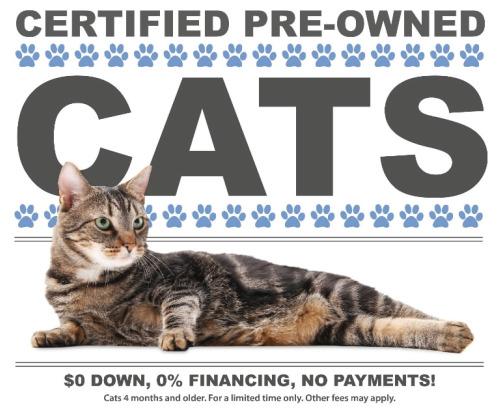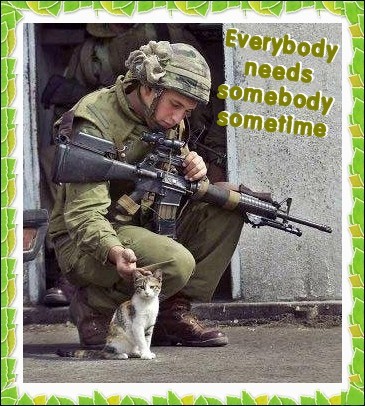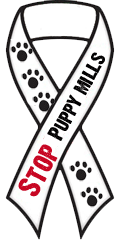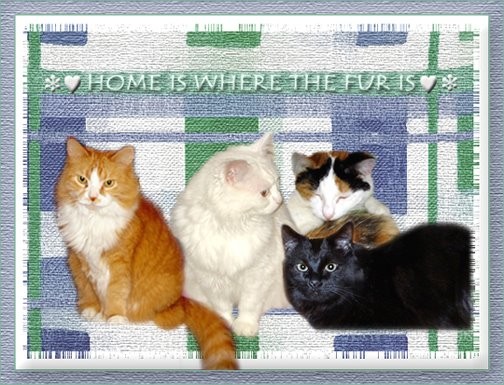Isn't it funny when something happens to your most ordinary day that connects with something else larger, much larger, than yourself? My local health department sent out a brochure and postcard to all residents of the county where I live. It was all about natural, or (heavens) man-disaster, and what part, if any, my household would play if one should take place.
On that card there were spots for doctors and nurses and contractors, and a little spot to write in what you would do if a disaster struck our area. I wrote in "animal rescue and animal welfare". I mailed that card yesterday and once it is received my name will be placed in a data base to be used by the members of our response team.
I am pleased to say that, even though my town is small (15,000 pop.) we have in place written instructions/protocol for the rescue, shelter and reunification of animals with their humans - large and small - should disaster strike.
On Monday, why don't you call your county seat to find out if you have a plan for animals during crisis. If not, call the rescue agencies in your area, call a meeting, and get busy on putting one together. One thing I now without even asking is that people who live alone, seniors, the disabled - none of them will leave their companions behind without duress. As for me, I have prepared an emergency kit for my animals with food, bottled water, copies of their inoculation records, a small First Aid kit, extra plastic ID tags, collars and leashes, and a couple of toys. One is in the trunk of my car and the other in my basement storage area. About every six months or so I rotate the food to keep it fresh.
Now, after you've read everything and checked out the links, look into the eyes of your cats and dogs, birds, even fish and turtles. Then - imagine telling them "good-bye" and that you are sorry but you have to leave - not knowing if you were telling them the truth. Not pleasant, right? Today is the day to get busy - so GET BUSY!
Please, let Confucius know that you are participating this week in the PURR and that you will do your part in keeping those who are most helpless safe - and - ALIVE! Mimi and the gang.

From the
HUMANE SOCIETY OF THE UNITED STATES:
Every year, hurricanes, tornadoes, hazardous-materials incidents, floods, earthquakes and other disasters threaten the animals who are so important to our lives. Members of The
HSUS National Disaster Animal Response Team (NDART™) learn how to prepare their families, help their community be better prepared and rescue and shelter animals when a disaster or crisis happens in their community or across the country.
If you are interested in joining HSUS NDART™ please read information on the following topics and recommended/required training:
Prepare Your Family and Pets,
Volunteer at your Local Animal Shelter
Training: NDART™ and Emergency Animal Sheltering Training,
Federal Emergency Management Agency Training,
Help Other Organizations,
The HSUS National Disaster Animal Response Team,
Application to Join NDART™
Prepare Your Family and Pets
As a trained responder, your first priority is to make sure your family and pets are taken care of when a disaster or crisis strikes.
Make a plan now, because when they are safe, you will be a more effective responder.
 Volunteering builds great skills
Volunteering builds great skills
Start volunteering at your
local animal shelter to gain practical experience in animal care and handling. This is excellent experience you can gain right in your own community.
Federal Emergency Management Agency (FEMA),
Independent Study Program
Any disaster responder, whether paid or volunteer, must take the following courses in order to be part of disaster response:
Incident Command System (IS 100)
Incident Command System for Single Resources/Initial Action Incidents (IS 200)
National Incident Management System (NIMS), an Introduction (IS 700)
The HSUS strongly recommends all its responders take the following FEMA courses:
Animals in Disaster: Module A—Awareness and Preparedness (IS 10)
Animals in Disaster: Module B—Community Planning (IS 11)
Livestock in Disasters (IS 111)
The FEMA Independent Study program has many useful and informative courses, which are quick and easy to take at home. For those interested in holding a supervisory-level position during a disaster, please review the information contained in the
FEMA Fact Sheet.
Help Other Organizations Active in Disaster Response
Are you unsure how you would react in a disaster situation, or even in a small-scale local emergency? Get some practical experience close to home and help your community, too.
American Red Cross: While the Red Cross does not have response teams for animals, many local emergencies involving families do involve their pets. By being part of your local Red Cross Disaster Action Team (DAT), you can help pets and people, too. The Red Cross does not set up shelters for pets, but they do care about pets in emergencies. They need to work with local humane groups to help the community provide disaster services to families with companion animals.
Locate your local American Red Cross chapter and look for these recommended classes for NDART™ volunteers:
- Human first aid/CPR
- Pet first aid/CPR
- Mass Care
- Shelter Operations
Introduction to Disaster Services
Citizens Emergency Response Teams: The
CERT program teaches you how to take care of your household and neighborhood until more help can arrive. CERT also trains citizens to be better prepared to respond to emergency situations in their communities. When emergencies happen, CERT members can give critical support to first responders, provide immediate assistance to victims, and organize spontaneous volunteers at a disaster site. CERT members can also help with non-emergency projects that help improve the safety of the community.

The HSUS Disaster Animal Response Team
The HSUS National Disaster Animal Response Team consists of animal care and control professionals, emergency services and rescue professionals, and other qualified volunteers. Team members are trained in community disaster response and preparedness as well as specialized response techniques for rescuing animals affected by disasters.
If you have skills and experience in animal handling, emergency/public services, or other disaster work and are interested in joining our DART, please explore the self-study courses listed above. Once you have taken several of these courses, particularly the FEMA Independent Study Programs, please visit the
HSUS Animal Disaster Response Training Calendar to see when and where you can take HSUS disaster courses. Because of the overwhelming response from people wishing to be volunteers, please understand that it may take a little while for us to get back to you.
To apply to become a member of the HSUS National Disaster Animal Response Team, please fill out the application at
www.ndart.org. Thank you for your support, and please make sure you have
a disaster plan for your own family, including pets!
If you've read this far and took some notes or bookmarked some of the links, THANK YOU from the beating hearts filled with unconditional love that rest at your feet. Mimi and her gang.
Week 17 of Purrs 4 Peace details are as follows:
Week seventeen’s appointed time is Sunday, October 4, 2009.
- Participants should purr for three minutes commencing at 3 p.m. EDT (U.S.) which is 8:00 p.m. (20:00 hrs.) BST in the U.K.
- The cat’s human staff should assist their cats with the project by stroking and nuzzling the cat at the appointed time.
- Please post your cat name and the country you purr in at www.confuciuscat.blogspot.com as a COMMENT if you are participating in this historic project. (posting a link to your own website-if you have one-is encouraged.) Or let me know by message on twitter or facebook.
- Posting purrs on facebook ( Acolytes of Confucius Cat or as friend to Alley Mason) and twitter (@ConfuciusCat) is encouraged, since it inspires purring in others, but not required. On twitter please use #purrs4peace in your tweets.









































.jpg)















































.jpg)















.jpg)


.jpg)






.jpg)




























.jpg)






